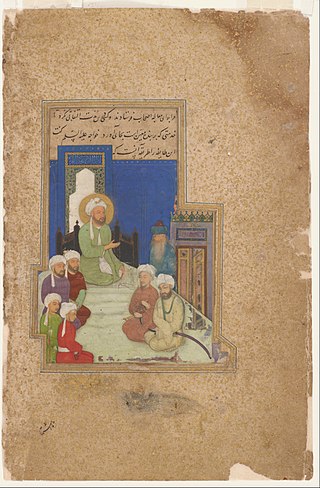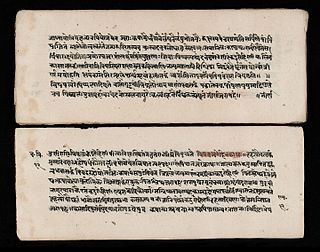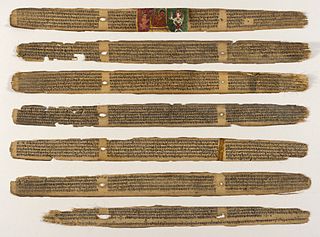Related Research Articles

The Kama Sutra is an ancient Indian Sanskrit text on sexuality, eroticism and emotional fulfillment in life. Attributed to Vātsyāyana, the Kama Sutra is neither exclusively nor predominantly a sex manual on sex positions, but rather was written as a guide to the art of living well, the nature of love, finding a life partner, maintaining one's love life, and other aspects pertaining to pleasure-oriented faculties of human life. It is a sutra-genre text with terse aphoristic verses that have survived into the modern era with different bhāṣyas. The text is a mix of prose and anustubh-meter poetry verses. The text acknowledges the Hindu concept of Purusharthas, and lists desire, sexuality, and emotional fulfillment as one of the proper goals of life. Its chapters discuss methods for courtship, training in the arts to be socially engaging, finding a partner, flirting, maintaining power in a married life, when and how to commit adultery, sexual positions, and other topics. The majority of the book is about the philosophy and theory of love, what triggers desire, what sustains it, and how and when it is good or bad.

The Panchatantra is an ancient Indian collection of interrelated animal fables in Sanskrit verse and prose, arranged within a frame story. The surviving work is dated to about 200 BCE, but the fables are likely much more ancient. The text's author is unknown, but it has been attributed to Vishnu Sharma in some recensions and Vasubhaga in others, both of which may be fictitious pen names. It is likely a Hindu text, and based on older oral traditions with "animal fables that are as old as we are able to imagine".
Ahmad al-Tifashi whose full name is Shihab al-Din Abu al-Abbās Aḥmad ibn Yusuf al-Ḳaysi al-Tifachi, born in Tiffech, a town in Souk Ahras Province was a Berber poet, writer, and anthologist, best known for his work A Promenade of the Hearts.

Jamal al-Din Muhammad ibn Muhammad ibn Muhammad ibn Fakhr al-Din al-Razi, also written al-Aqsara'i, was a 14th-century Muslim Iranian physician. He became known as Aqsara'i because he moved to Aqsara region of what is now Turkey.

Ghiyāth al-Dīn ʿAlī ibn Ḥusayn ibn ʿAlī Amīrān Iṣfahānī was a fifteenth-century Persian physician and scientist from Isfahan, Iran. He was, in the words of Daniel Beben, 'a polymath in the service of several of the Timurid governors of Badakhshān in the second half of the 15th century' CE. Little is known of him beyond the works attributed to him.

Muhammad ibn Yusuf al-Harawi was a Persian late 15th century physician from Herat, Safavid Iran, now part of Afghanistan.
Maqsud Ali Tabrizi was a 17th-century Iranian physician in Mughal India.
Muhammad Akbar ibn Mir Hajji Muhammad Muqim Arzani also known as Shah Mohammad Arzani Dehlavi was an 18th-century Persian physician in Mughal India.
Muhammad Hussayn ibn Muhammad Hadi al-‘Aqili al-‘Alavi al-Khurasani al-Shirazi was a Persian physician from the 18th century from Shiraz.
Rostam Gorgani was a mid-16th century Persian physician who lived in India.

Muḥammad Mu’min ibn Mīr Muḥammad Zamān Tunakābunī was a 17th-century Persian physician from Mazandaran.
Nur al-Din Muhammad Abd-Allah ibn Hakim ‘Ayn al-Mulk Qurayshi Shirazi was a mid 17th century Persian physician in Mughal India.

The Bāburnāma is the memoirs of Ẓahīr-ud-Dīn Muhammad Bābur (1483–1530), founder of the Mughal Empire and a great-great-great-grandson of Timur. It is written in the Chagatai language, known to Babur as Türki ("Turkic"), the spoken language of the Timurids. During the reign of emperor Akbar, the work was translated into Persian, the usual literary language of the Mughal court, by a Mughal courtier, Abdul Rahim Khan-i-Khanan, in AH 998.

The Charaka Samhita is a Sanskrit text on Ayurveda. Along with the Sushruta Samhita, it is one of the two foundational texts of this field that have survived from ancient India. It is one of the three works that constitute the Brhat Trayi.

The Sushruta Samhita is an ancient Sanskrit text on medicine and surgery, and one of the most important such treatises on this subject to survive from the ancient world. The Compendium of Suśruta is one of the foundational texts of Ayurveda, alongside the Charaka-Saṃhitā, the Bhela-Saṃhitā, and the medical portions of the Bower Manuscript. It is one of the two foundational Hindu texts on the medical profession that have survived from ancient India.

Tutinama, literal meaning "Tales of a Parrot", is a 14th-century series of 52 stories in Persian. The work remains well-known largely because of a number of lavishly illustrated manuscripts, especially a version containing 250 miniature paintings commissioned by the Mughal Emperor Akbar in the 1550s. The Persian text used was edited in the 14th century from an earlier anthology ‘Seventy Tales of the Parrot’ in Sanskrit compiled under the title Śukasaptati dated to the 12th century. In India, parrots are popular as storytellers in works of fiction.
Śukasaptati, or Seventy tales of the parrot, is a collection of stories originally written in Sanskrit. The stories are supposed to be narrated to a woman by her pet parrot, at the rate of one story every night, in order to dissuade her from going out to meet her paramour when her husband is away. The stories frequently deal with illicit liaisons, the problems that flow from them and the way to escape those crises by using one's wits. Though the actual purpose of the parrot is to prevent its mistress from leaving, it does so without moralising. At the end of the seventy days, the woman's husband returns from his trip abroad and all is forgiven. Most of the stories are ribald and uninhibited, with some verging on the pornographic. The situations depicted in the stories not only test the bounds of marriage, some stray into taboo areas of incest and, in one case, zoophilia.

Jāmiʿ al-tawārīkh is a work of literature and history, produced in the Mongol Ilkhanate. Written by Rashid al-Din Hamadani at the start of the 14th century, the breadth of coverage of the work has caused it to be called "the first world history". It was in three volumes and published in Arabic and Persian versions.
Sadid al-Din Muhammad ibn Mas‘ud al-Kazaruni was a 14th-century Persian physician from Kazerun, Fars, Iran.
Abdullah Tabib, also known as Abdullah Yazdi, was a Unani physician and writer from the Golconda Sultanate of present-day southern India. He is best known for writing the medical book Farid, also known as Tibb-i Faridi.
References
- ↑ Donzel, E. J. van (1 January 1994). Islamic Desk Reference . BRILL. p. 310. ISBN 90-04-09738-4.
Nakhshabi, Shaykh Diya* al-Din: famous Persian author; xivth c. He used his knowledge of Indian languages to translate Indian books into Persian. The best known is The Book of the Parrot.